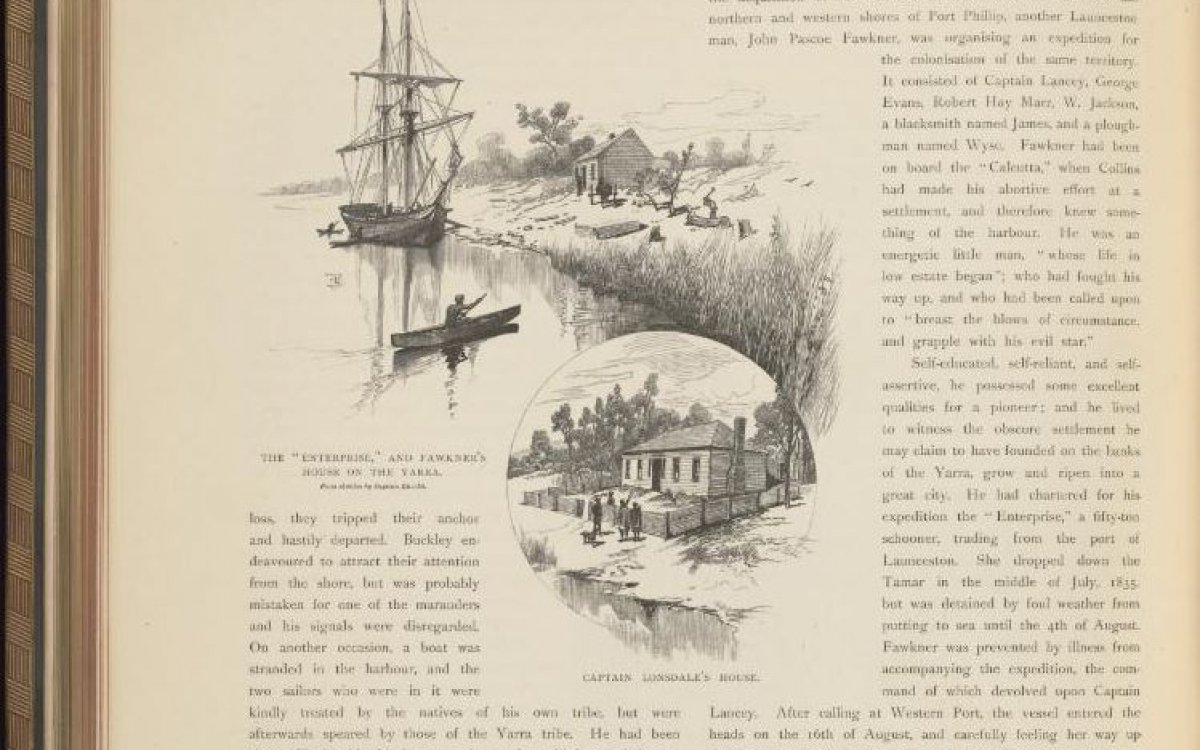Due to scheduled maintenance, the National Library’s online services will be unavailable between 8pm on Saturday 7 December and 11am on Sunday 8 December (AEDT). Find out more.

Mahony, Frank, 1862-1916 & Fullwood, A. Henry (Albert Henry), 1863-1930 & Sydney Mail. (1888). A. J. C. Autumn Meeting, the lawn at Randwick, 1888. http://nla.gov.au/nla.obj-565906176

(1888, March 31). The Sydney Mail and New South Wales Advertiser (NSW : 1871 - 1912), p. 689. http://nla.gov.au/nla.news-page16908027
The publication of the Picturesque Atlas was situated within a ‘golden age’ of illustration: the great global explosion of mass-produced images that occurred between 1850 and 1900 with the rise of the illustrated press.
The Technology of Illustration
Illustration was an unashamedly commercial and collaborative artform, engaging the talents of artists, engravers, photographers and printers. Art had in fact become an industry. By the 1860s advances in ‘photo-process’ wood engraving and printing technologies enabled engravers to reproduce pictures with astonishing accuracy. The best results were achieved when they were able to work with an original artwork, which had also been photographed and projected on to a sensitised wood block. Engravers required extraordinary dexterity and skill to incise a picture’s subtle shadings and tonality onto a hardwood block. Indeed, many engravers were themselves talented artists, such as the English-born and French-trained Collingridge brothers, George and Arthur.

Mahony, Frank, 1862-1916. (1896). Henry Lawson in 1896 [picture] / F.P. Mahony. http://nla.gov.au/nla.obj-136254778

Lawson, Henry, 1867-1922 & Lawson, Bertha, 1876-1957 & Garnett, Edward, 1868-1937 & Garnett, David, 1892-1981 & Kiernan, Brian (Brian Francis), 1937- & Whelan, Phyllis & Watson, Frederick, 1878-1945. (1896). In the days when the world was wide and other verses / by Henry Lawson. Sydney : London : Angus and Robertson ; Young J. Pentland http://nla.gov.au/nla.obj-128443420
Henry Lawson held that only two artists could illustrate his work: Frank Mahony and George Lambert. This portrait of Lawson—made after Mahony’s original drawing, formerly in John Alexander Ferguson’s collection, now in the State Library of NSW—depicts him as the swagman who ‘tramps and tramps and tramps’.
In the Days When the World Was Wide and Other Verses was the first collection of poems by Australian poet and author Henry Lawson. Dedicated to The Bulletin editor J.F. Archibald, its frontispiece features Mahony’s portrait of Lawson ‘on the wallaby track’.
Henry Lawson held that only two artists could illustrate his work: Frank Mahony and George Lambert. This portrait of Lawson—made after Mahony’s original drawing, formerly in John Alexander Ferguson’s collection, now in the State Library of NSW—depicts him as the swagman who ‘tramps and tramps and tramps’.
In the Days When the World Was Wide and Other Verses was the first collection of poems by Australian poet and author Henry Lawson. Dedicated to The Bulletin editor J.F. Archibald, its frontispiece features Mahony’s portrait of Lawson ‘on the wallaby track’.
The Art of Illustration
Between 1850 and 1900 the illustrated press relied far more on artists for its images than photographers, partly due to the camera’s technical limitations. As a result, wood-engraved images became the era’s most widely seen art.
Illustrated newspapers employed thousands of artworkers, many of whom pursued successful careers as etchers and painters. These included European artists like Félix Buhot and Frank Holl, whose work influenced and was admired by James Abbott McNeill Whistler and Vincent van Gogh, respectively.
Australian publishers generally imported their artist–illustrators from England, including Julian Ashton, A. Henry Fullwood and Constance Roth. Two exceptions were the Sydney-trained artists William Macleod and Frank Mahony.
Activities
Reproductive Printmaking
The Picturesque Atlas is a masterclass in the techniques of fine-art engraving and for illustration.
Have students explore the processes behind the following styles of printmaking:
- Woodcut
- Engraving
- Lithography
- Photomechanical
As an example of the power of ‘photo-process’ engraving, set a task for students to reproduce a painting using linocut printing.
They should first make a linocut reproduction of the image from a screen or on a page in front of them.
Next, to simulate the ‘photo process’, use an old overhead projector to project the same image the onto the lino block as they cut the design.
Compare the two prints for accuracy in reproduction.
Drawing
The artists of the Picturesque Atlas were well-trained draughtspeople.
Have students compare the following preparatory drawings with the resulting engraved versions appearing in the Atlas. Pay special attention to line, shading and composition. How have these visual conventions been maintained in the reproductions?

Angas, George French, 1822-1886. (1860). Chambers' Pillar [picture] / [George French Angas]. http://nla.gov.au/nla.obj-134524168

Garran, Andrew, 1825-1901. (1886). Picturesque atlas of Australasia / edited by Andrew Garran. Sydney : The Picturesque Atlas Publishing Co. http://nla.gov.au/nla.obj-1759526180

Smedley, W. T. (William Thomas), 1858-1920 & Liardet, W. F. E. (Wilbraham Frederick Evelyn), 1799-1878. (1887). The Enterprise, and Fawkner's house on the Yarra ; Captain Lonsdale's house [picture] / W.T. Smedley. http://nla.gov.au/nla.obj-135236956

Garran, Andrew, 1825-1901. (1886). Picturesque atlas of Australasia / edited by Andrew Garran. Sydney : The Picturesque Atlas Publishing Co. http://nla.gov.au/nla.obj-1759450938







